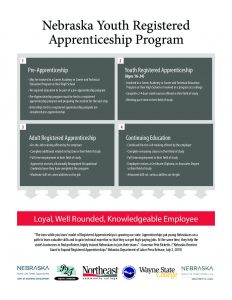Apprenticeships
Registered apprenticeships are innovative work-based learning and postsecondary earn-and-learn models that meet national standards for registration with the U.S. Department of Labor (or federally recognized State Apprenticeship Agencies. They provide on-the-job training while safeguarding the welfare of apprentices.
For an Introduction to Apprenticeship that contains links to excellent resources, visit:
WorkforceGPS – Introduction to Apprenticeship
Definition
Registered Apprenticeships are innovative work-based learning and post-secondary earn-and- learn models that meet national standards for registration with the U.S. Department of Labor (or federally recognized State Apprenticeship Agencies. Registered Apprenticeship training is distinguished from other types of workplace training by several factors:
1. participants who are newly hired (or already employed) earn wages from employers during training;
2. programs must meet national standards for registration with the U.S. Department of Labor (or federally-recognized State Apprenticeship Agencies;
3. programs provide on-the-job learning and job-related technical instruction;
4. on-the-job learning is conducted in the work setting under the direction of one or more of the employer’s personnel; and
5. training results in an industry-recognized credential
Purpose/Objective: Career Exploration
Registered Apprenticeship opportunities include on-the-job training, and classroom instruction provided by apprenticeship training centers, technical schools, community colleges, and even distance learning. Often Registered Apprenticeship sponsors work directly with community colleges that ultimately provide college credit for apprentice.
Benefits
- First and foremost, Apprenticeship sponsors develop highly skilled employees. Once established, Apprenticeship programs also reduce turnover rates, increase productivity, lower the cost of recruitment, and increase safety in the workplace/job site.
- Registered Apprenticeship is used widely across all industries and includes union and non-union programs. Registered apprenticeship sponsors include unions, but also employers, community colleges and universities, workforce investment boards, industry associations, and the military.
- Today, most Registered Apprenticeship opportunities include on-the-job training, and classroom instruction provided by apprenticeship training centers, technical schools, community colleges, and even distance learning. Often Registered Apprenticeship sponsors work directly with community colleges that ultimately provide college credit for apprentice.
- After completion of an apprenticeship program, the apprentice earns a nationally recognized credential from the Department of Labor that is portable and stackable.
Additionally, an apprentice, along with earning a paycheck throughout the apprenticeship, is also elevated to journey-worker status that leads to increased pay and upward career opportunities.
Key Legal, Safety and Health Issues
The U.S Department of Labor’s Office of Apprenticeship, works in conjunction with State Apprenticeship Agencies to administer the program nationally. These agencies are responsible for registering apprenticeship programs that meet federal and state standards; protecting the safety and welfare of apprentices; issuing nationally recognized and portable Certificates of Completion of Apprenticeship to apprentices; promoting the development of new programs through marketing and technical assistance; assuring that all programs provide high quality training; and assuring that all programs produce skilled and competent workers. In addition, a wide variety of stakeholders exist, including state organizations, industry associations, educational organizations (both secondary and post-secondary), workforce development organizations, economic development organizations, community-based organizations, and others. These stakeholders have a substantial interest in its success of Registered Apprenticeship.
Prerequisites
Registered Apprenticeship program sponsors identify the minimum qualifications to apply for a program. The eligible starting age can be no less than 16 years of age; however, individuals must usually be 18 to be an apprentice in hazardous occupations. Program sponsors also identify additional minimum qualifications to apply, (e.g., education, ability to physically perform the essential functions of the occupation, proof of age.) All applicants are required to meet the minimum qualifications.
For more information
The US Department of Labor maintains a number of web-based resources. Here you can find our newest technical assistance products including our Quick Start Toolkit, which provides helpful steps and resources to start and register an apprenticeship program as well as our Federal Resources Playbook, which provides information on using the other Federal funds and resources to support your registered apprenticeship program. For more on Registered Apprenticeship, please visit the USDOL online. Also, find out what’s happening throughout the Registered Apprenticeship system.





